I often hear companies use the excuse that their culture is preventing them from adopting Lean product development, or making other positive changes. That’s too bad, because cultural resistance is actually easy to overcome—if you know how.
Barriers to adopting Lean product development
If you’ve read the previous posts in this series about Lean product development, you can skip the next paragraph. If not, I’ll outline how we got here.
In the first four posts, I talked about how Lean product development is the biggest opportunity you’ll see in your lifetime, and then gave an example of the dramatic results that are possible when you focus on the right end of the value chain. And then I outlined the three best sources for getting started with Lean Product Development (Don Reinertsen, Agile and Theory of Constraints).
So now I’ll share what barriers you’ll typically encounter when you start to implement any Lean or Agile methods in your hardware teams, and why cultural resistance is not the problem everyone thinks it is.
If you think cultural resistance will be a barrier to change in your company, you’re not alone. According to the Aberdeen Group report, Getting the Process Right (September 2008), the top ranked challenge to successful process improvement in new product development was "cultural resistance to change."
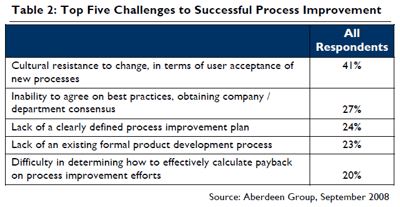
And it won by a wide margin. But I can dispel this myth and explain why it’s not really a problem, and how you can get around it.
Let’s take a look at what happens when someone is faced with change...
Phases of Cultural Change
The diagram below shows the phases a person goes through before they completely accept a change and move on.
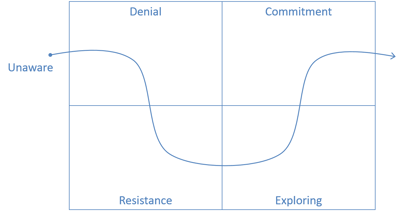
Our initial state is to be unaware that a change may be necessary. Then something happens that makes us aware of the possibility. But first we deny it, and then resist it, before we start exploring. And if one of the solutions we try is acceptable, we commit to it and move on. (This process happens every time someone is faced with change, but the length of time it takes to get through it can vary from a few seconds to many years!)
When you put the list of challenges from the Aberdeen report on this path you can see why it’s difficult to get any kind of Lean product development improvement to stick in a company. For clarity I left out “Lack of an existing formal product development process” because most companies have some form of a process in place.
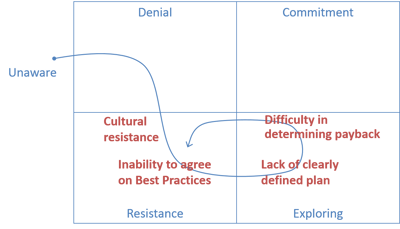
Notice that if you manage to push through the cultural resistance, but you can’t agree on best practices, don’t have a plan, and can’t determine the payback, it’s no wonder you won’t get commitment...!
To make matters worse, you can see you’ll be recycled back to the resistance phase where it will be more difficult the second time through. And there’s only a small number of times you can go through this process and fail until the resistance gets so big it’s impossible to try again.
So what do we do?
Fortunately, there is a solution.
Cultural resistance to change is a symptom, not a root cause.
I know that sounds controversial, but I can prove it.
Discovering Root Causes Using Current Reality Trees
Let’s take a look at a basic root cause diagram. We learned this format from another great book, The Logical Thinking Process: A Systems Approach to Complex Problem Solving, by H. William Dettmer. (It’s also one of the subtopics of Theory of Constraints.)
Mr. Dettmer demonstrates how to develop a Current Reality Tree (CRT) to identify root causes in complex systems. We used them for many year in our diagnosis phase of consulting projects and found them to be very useful for a number of reasons. They not only help you clearly identify the root causes of complex problems, they’re a great way to clearly communicate the situation, get buy-in and consensus from all parties involved, and develop the correct solution.
Without going into a lot of detail, you start by listing all of the issues you can think of (usually on sticky notes). Then you sort and order them by cause and effect. And when you’re done, the root causes will be at the bottom, and the symptoms will be at the top.
Let’s look at a simple example. To read this, start at the bottom and say, “If…” and then read the bottom box. Then say, “Then…” and read the top box.

“If the sun goes down, then the sky gets dark.” Pretty obvious, right? Now try reading it the other way. It’s also obvious that the opposite isn’t true. So now we can be sure which is the cause and which is the effect, or symptom.
But not all effects have only one cause. For example, in order to have fire, I need fuel and an ignition source. So that would look like this…

“If I have fuel, AND I have ignition, then I have fire.”
Without getting into too much detail, in the example above it’s clear you need both of the elements for the effect to be realized. This is called a “conceptual and” and is noted with an ellipse that the arrows pass through. In other cases, the symptom has multiple causes that each add to the effect. Those are called “magnitudinal ands” and are noted by a bowtie symbol with “MAG” in the center.
So, if we write down the four issues in the Aberdeen study (leaving out “lack of a formal NPD process” again) and organize them, we’d end up with this CRT.
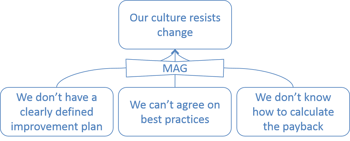
Which would read something like… “If we don’t have a plan, and can’t agree on best practices, and don’t know how to calculate the payback… Then our culture will resist the change.”
Doesn’t that make a lot of sense? And it’s clear now…
Cultural resistance is the symptom, not the cause!
OK, so what do we do about it?
To answer that, let’s look at the phases of change diagram with the necessary solution steps laid out in the right phases.
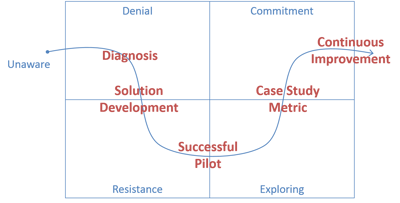
A properly run diagnosis will get everyone out of the denial phase. A solution based on the diagnosis and created with input from the team will generate the necessary buy-in to try something. A successful pilot will eliminate any remaining resistance. And a great result will get commitment to continue.
And each time this process is executed successfully, it becomes easier to do the next time!
It really is that simple.
Be sure to subscribe to this blog to get the rest of the story.
Related Posts
In part 1, we cover the science and economics behind “failing fast” and the optimum rate of failure when learning.
In part 2, we discuss why Lean product development really is the opportunity of the century.
In part 3, we share an incredible case study that demonstrates the unexpected results that can be achieved when you apply the proper set of Lean product development principles.
In part 4, we discuss the Lean product development value chain and why in hardware development we have spent too much time focusing on the wrong end.
In part 5, we share tips on how to get started with Lean product development.
In part 6 we discuss other key principles of Lean product development.
Lean Product Development: Barriers to Adoption
In part 8 we share 4 ways to ensure your Lean product development initiative won't fail.
In this post, part 7, we discuss why cultural resistance in not the key barrier to Lean adoption...



